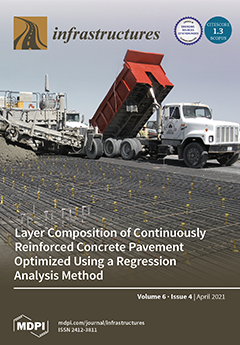A procedure for determining the optimized composition of layer properties for a continuously reinforced concrete pavement (CRCP) system was constructed using field tests, finite element (FE) analysis, and regression analysis methods. The field support characteristics of a rigid pavement system were investigated using
[...] Read more.
A procedure for determining the optimized composition of layer properties for a continuously reinforced concrete pavement (CRCP) system was constructed using field tests, finite element (FE) analysis, and regression analysis methods. The field support characteristics of a rigid pavement system were investigated using a falling weight deflectometer (FWD), dynamic cone penetrometer (DCP), and a static plate load test. The subgrade layer exhibited a more uniform condition than the aggregate base, and the modulus of the subgrade reaction of the aggregate base and subgrade combination (effective
k-value) was improved by about 1.5 times by introducing a 2 inch (50.8 mm) asphalt stabilized base (ASB) layer. Thereafter, FE support models describing the actual field conditions were studied. The effects of the thickness of the stabilized base layer, the elastic modulus of the stabilized base material, and the effective
k-value on the composite
k-value of the support system were identified using a regression analysis method, and the results showed that the variables had a similar effect when determining the composite
k-value. Afterward, a procedure for selecting the layer properties for producing a suitable composite
k-value was constructed, and we identified that the maximum stress in the concrete slab was induced at different levels, even with identical composite
k-values. Lastly, regression relationships were derived to estimate the maximum stress in the concrete slab by considering both the support layer properties and the concrete slab. Subsequently, an algorithm for selecting an optimized layer composition of the CRCP structure was construction considering the economical aspect.
Full article





